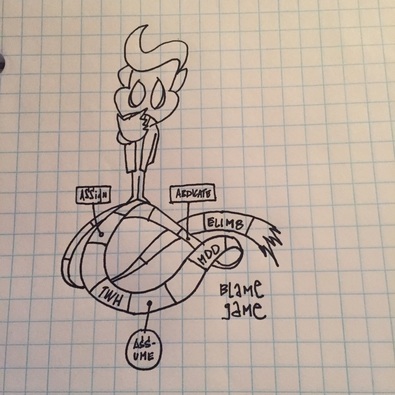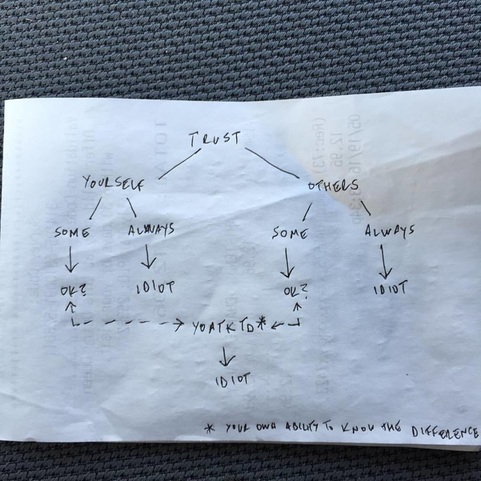 If you have a team, especially a smaller team, there are no secrets – there are only those issues that you take leadership over and discuss with a purpose and those issues that you allow to direct their own lives. In most offices the walls are paper thin (if you still have walls) and the issues are being discussed like ping pong balls bouncing from surface to surface. As a leader you can be observe from your perch and imagine that you are the referee keeping the game within its imaginary bounds or you can grab a paddle and lead the discussion. There is safety on the sidelines, but it is only imagined, as those ping pong balls can cause real damages to teams and culture if they are not addressed. Leaders on the sidelines are not leaders, they are observers. Leaders who engage with their paddles will win some and will lose some, but by being present they can reduce negative impacts and even intercede in additional balls being added to the natural chaos of business life. There is no perfect leadership but there is definitely detrimental action/inaction by leaders. The ping pong balls are flying, its time to paddle up.
0 Comments
Many leaders would proudly boast of their advanced degree received from the Institute of Tired Leadership Open Door-ism. At the suggestion that said leaders do not engage their employees or that they dismiss their team member’s input or feedback, said leaders would pound their fists in outrage and point to the certificate from the ITLOD. Unfortunately for leaders, the open door policy does involves more than leaving your door partially open during business hours and consequently there is more than one way to dismiss another person’s input or feedback, even if you graduated with honors.
Dismissal upon the transmission of input. The door was open. The employee knocked, confirmed and ventured through (not as open as open would indicate). The employee begins to engage with the leader and the leader A) engages with listening, body language and words or B) dismisses the feedback by the same gestures. Input from employees may not come at times that are of convenience to the receiving party but are always of some level of importance to the transmitting party. Dismissal following the transmission of input. The door was open. The employee shared their feedback. The leader made it through the conversation and communicated that the information was received with importance, what will the leader do to follow up with the input received from the team? The leader A) conducts a proper investigation into the information preferred to determine appropriate action or B) dismiss the input by doing nothing to follow up on the feedback received. Employees do not expect leaders to be omniscient, to know everything that is going on, but they do expect leaders to engage when a negative action is brought to the attention of leadership (more on this HERE). Dismissal of the confirmation of input. What happens when the leader listens, the leader investigates and then the leader confirms the input received by their employee? If an appropriate response or action is warranted, the test of leadership is now on display – what will the informed leader do? Leaders should not want themselves to be ignorant of issues, this is one of the great values of a truly open door, that employees are willing to share earnest concerns with leadership so that the team can address issues and maintain health should be celebrated. An ignorant leader who becomes informed and yet refuses action displays impotence. Why should employees care enough to make positive changes when leadership has demonstrated that it is not valued by them? Leadership is an extension of customer service within your organization. When leaders demonstrate care and service to their employees they perform several key functions including engaging their employees, encouraging positive action and demonstrating how the organization treats people. A healthy organizational culture is an extension of the positive example of leaders who are engaged in the processes of the team and the activities of employees who reinforce those values to each other as well as their customers. Earnest input and feedback from team members at every layer within the organization is critical to progress and growth. A company with no input from team members either has employees that do not care or employees who have concluded from the actions (dismissal) of management that leadership does not care.  How leaders respond to conflicts can either reinforce cultural values that strengthen the team or they can respond in ways that destroy morale. In organizational cultures everyone loves playing The Blame Game and bosses are particularly fond of the follow up game, Crap Rolls Downhill. Both are games are trademarked but neither has any clearly defined rules or pre-determined outcomes. The game is often initiated by conflict and the fantastical response of leadership to avoid responsibility for resolution. Play number one is to assign. This phase of the game is also so joyously referred to as The Witch Hunt. The dice are shaken, rolled and a conflict of sorts ensues as the numbers clamber upon the playing surface. Whether the inquisition is over employee issues, customer service, payments, product failures or the like, bosses will rally the wagons, feigning a quick and concerned response. As the dust settles on the parade of indignation the supervisory fingers are drawn from their holsters with an insatiable thirst for flesh. Assignment of blame is seen by many as a gold star in the managerial belt. If someone can be blamed then we can all conclude that The Witch Hunt was successful. All that a conflict needs in order to be resolved is for some party to be assigned the blame. Shake the dust from our hands and the sweat from our brows, our job is d-o-n-e. Play number two is to assume. When blame cannot be immediately assumed and The Witch Hunt cannot be satisfied, the participants of the game have to make a choice whether they will draw upon the Actually-Investigate-An-Issue card or select from the much thicker Deck of Assumptions. The scientific process is only for nerds, right? Why would any self-respecting manager, who’s time is worth more than pure San Francisco gold, dip their manicured fingers into the Mire of Dispute Discernment? Most management practitioners believe they have achieved their success by trusting their trustworthy gut, so why would conflict resolution be any different? The savvy boss already knows who is guilty, they don’t need crime scene analysis, jury review or the Supreme Court to tell them what they already assume is correct. Play number three is to abdicate. If the dice aren’t rolling correctly and assigning blame nor assumptions are advancing the player through business Candyland, the next option is to pull the wild card that enables a manager to abdicate responsibility. In these scenarios of unresolved conflicts a boss must draw upon prior experience to climb a ladder to boost themselves above the strife or quickly chute down and away from the controversy. If there is a report that says issues will resolve themselves then it must be right and it should be believed. The final alternative play that no one wants to talk about, like it’s some sort of cheat code that no one understands is to eliminate. Elimination of the conflict requires identification of the cause. Why are we in the negative situation that we find ourselves confronted with? What root sources do we need to address in order to ensure that we do not replicate the negative effects? Conflicts are continuous, they can happen at any moment for various reasons and they create an opportunity for growth within the organization. Unfortunately conflicts require leaders to get their hands dirty fixing people issues and process malfunctions but they also remind leaders to be hands on with people and processes. Elimination (Secret Code) Instructions: Crap hits the fan. Find the crap. Get the crap out of the system. Get the crap into a toilet. Flush the crap as soon as possible. Don’t pretend the crap doesn’t exist. Don’t smear the crap all around the office. Don’t kid yourself that the crap will take care of itself.  How does one avoid being an idiot in the analysis and conclusions drawn from information gathered? Do not trust anything that one cannot confirm for oneself, right? Under such a premise, one must trust one’s own ability to discern information and draw appropriate conclusions. If one trusts one’s own abilities to filter through multiple points of data and infer correctly from the information drawn from, how consistently can the self-source evaluation be trusted? If one trusts one’s own self some/most of the time this may only be a safe bet some of the time at best. If one trusts one’s own self always, one can safely self diagnose one’s own self as an idiot. If one does not want to be an idiot by way of self trust, then one may conclude that they should seek out the input and knowledge of others. When wise counsel is sought, one must still, at some point, rely upon one’s own internal discernment abilities to determine whether the analysis performed by others is reliable. Even smart and reliable people have limitations and can be wrong from time to time, so no one person can be trusted 100% of the time. If one trusts others some/most of the time this may only be a safe bet some of the time at best. If one trusts others always, one can safely be diagnosed by others as an idiot. The only option that remains is a hybrid of the previously discussed options, inform one’s self while learning when to trust the input of others. Yet the paradox continues, can one trust what we ubiquitous analysts call the YOATKTD metric – Your Own Ability To Know The Difference. As it turns out, in the effort to avoid being an idiot, the only options are to trust one's self or to trust others and in the final analysis one very likely will find that there is little than anyone can do to avoid it. |
AuthorThoughts on personal and professional development. Jon Isaacson, The Intentional Restorer, is a contractor, author, and host of The DYOJO Podcast. The goal of The DYOJO is to help growth-minded restoration professionals shorten their DANG learning curve for personal and professional development. You can watch The DYOJO Podcast on YouTube on Thursdays or listen on your favorite podcast platform.
Archives
March 2023
Categories
All
<script type="text/javascript" src="//downloads.mailchimp.com/js/signup-forms/popup/unique-methods/embed.js" data-dojo-config="usePlainJson: true, isDebug: false"></script><script type="text/javascript">window.dojoRequire(["mojo/signup-forms/Loader"], function(L) { L.start({"baseUrl":"mc.us5.list-manage.com","uuid":"b9016446bd3c6a9f0bd835d4e","lid":"83282ffb9e","uniqueMethods":true}) })</script>
|
Jon Isaacson |
Connect. Collaborate. Conquer.
© COPYRIGHT 2015. ALL RIGHTS RESERVED.
|



 RSS Feed
RSS Feed